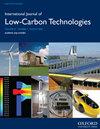CFD Modeling of a Horizontal Wind Turbine by Utilizing Solar Nozzle for Power Production
IF 2.3
4区 工程技术
Q3 ENERGY & FUELS
引用次数: 1
Abstract
In this study, utilizing air velocity by converting wind kinetic energy into mechanical energy due to the converging area, has been numerically studied by proposing a 3D novel model and using ANSYS Fluent 19 software. Solar radiation by using the radiation model (S2S) has been considered to benefit from the heat energy to be converted into kinetic energy of the flow. Ultimate dimensions were calculated for the proposed nozzle is made of glass material. The study concentrates on the utilization of solar nozzles and their effect on wind energy. This study focused on and attempted to increase the local wind velocity (1 m/sec) in Kirkuk city in Iraq, to a higher velocity that could produce a large amount of kinetic energy which is then converted to generate power. Hence, increasing the efficiency of the plant. Results showed that wind velocity increases as the heat gain increases and the area decreased. The velocity at the converging position without including the solar radiation model reached about (15.1 m/sec), while in the case of enabling the solar radiation, it showed a value of (15.75 m/sec). As a result, the power produced from this proposed method has increased by a value of 74 W.利用太阳能喷嘴发电的水平风力涡轮机CFD建模
在这项研究中,通过提出一个新的三维模型并使用ANSYS Fluent 19软件,对通过将风动能转换为收敛区产生的机械能来利用空气速度进行了数值研究。通过使用辐射模型(S2S)的太阳辐射被认为受益于将被转换为流动动能的热能。对拟用玻璃材料制成的喷嘴的极限尺寸进行了计算。研究的重点是太阳能喷嘴的利用及其对风能的影响。这项研究的重点是并试图将伊拉克基尔库克市的当地风速(1米/秒)提高到更高的速度,从而产生大量动能,然后将其转化为发电。因此,提高了工厂的效率。结果表明,风速随热增量的增加和面积的减小而增大。在不包括太阳辐射模型的情况下,会聚位置的速度达到约(15.1米/秒),而在启用太阳辐射的情况下显示出(15.75米/秒。
本文章由计算机程序翻译,如有差异,请以英文原文为准。
求助全文
约1分钟内获得全文
求助全文
来源期刊

International Journal of Low-carbon Technologies
Engineering-Architecture
CiteScore
4.30
自引率
4.30%
发文量
106
审稿时长
27 weeks
期刊介绍:
The International Journal of Low-Carbon Technologies is a quarterly publication concerned with the challenge of climate change and its effects on the built environment and sustainability. The Journal publishes original, quality research papers on issues of climate change, sustainable development and the built environment related to architecture, building services engineering, civil engineering, building engineering, urban design and other disciplines. It features in-depth articles, technical notes, review papers, book reviews and special issues devoted to international conferences. The journal encourages submissions related to interdisciplinary research in the built environment. The journal is available in paper and electronic formats. All articles are peer-reviewed by leading experts in the field.
 求助内容:
求助内容: 应助结果提醒方式:
应助结果提醒方式:


